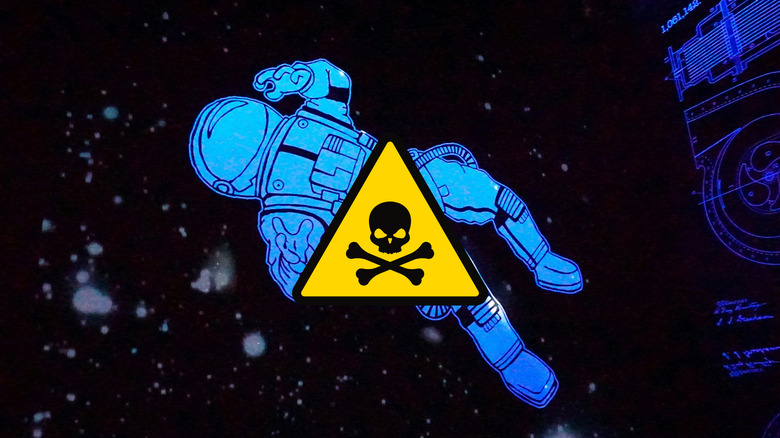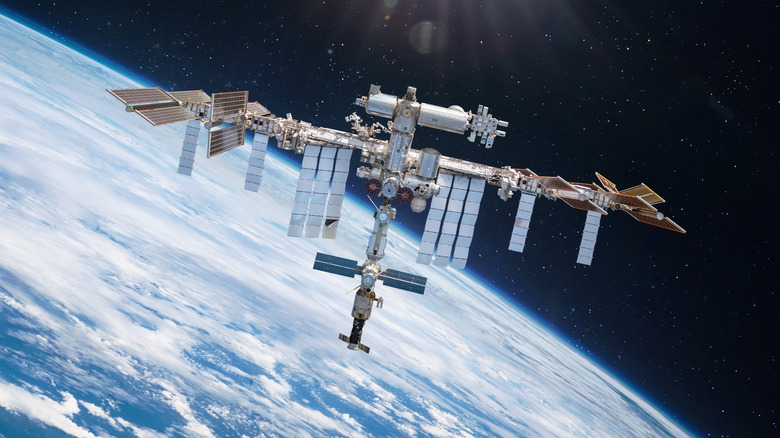What Happens If An Astronaut Dies In Space?
Space exploration is one of the most dangerous things humans do. On January 28, 1986, the Challenger space shuttle infamously exploded 73 seconds into launch, killing all seven crew members on board. In April of 1967, Vladimir Komarov, a Russian cosmonaut onboard the Soyuz 1 spacecraft, died when the craft's parachutes failed to deploy properly upon reentry, causing him to crash into Earth. But as our species continues to expand its presence in the cosmos, it's all but certain that not every death in space will be a dramatic one involving malfunctioning launch equipment or fiery crashes. It is, after all, one of the bad things about space exploration that comes with the territory. And while it's not exactly a fun thing to consider — like how solid waste management on the International Space Station works — it's an unavoidable reality.
So, what happens when an astronaut dies of natural causes during an extravehicular activity, for example? It's something NASA has long considered, even though no astronaut has yet died beyond Earth's atmosphere in this way. The risk, however, is real. A sudden medical emergency during a spacewalk, a catastrophic system failure aboard a spacecraft in orbit, or trauma from space debris could all, in theory, result in a crew member's death.
NASA's upcoming Artemis II mission will send a crewed spacecraft around the moon by late 2025, in preparation for future crewed missions to the moon and beyond. And sending humans to Mars in the coming decades is a top priority for the agency, one that will challenge scientists and engineers like never before. It also means having protocols in place for an astronaut's demise. Beyond just logistics, there's the psychological toll other astronauts would have to manage in an already high-risk environment. Here's what such an event would look like.
Death in space
In the event of the death of a single individual onboard, say, the International Space Station, the NASA-STD-3001 Technical Brief on mortality related to human spaceflight stipulates that a multi-stage procedure be followed. The first step is to ensure the safety of the surviving crew, followed by an official pronouncement of death, logging the death in the station's official records, forensic investigations, and finally, containment and disposition of the remains.
Once the crew has secured their environment, meaning they are certain whatever led to the death of their crew member will not also put their lives at risk, the next step is the formal pronouncement of death. Who is authorized to issue such a pronouncement, along with the details connected to a death certificate, must be determined before astronauts arrive at the station. Depending on the circumstances surrounding the death and the crew's capabilities, forensic sampling could be required onboard the station. The body might be kept in the astronaut's suit or stored using a commercial human remains containment unit that was flown up to the station in 2012.
Samples that will later be used in a thorough forensic analysis back on Earth may include blood, fingernails, hair, or urine, some of which must be refrigerated within a 12-hour window. Forensic analysis can likewise include documenting the body and removing the astronaut's suit and other personal effects, all depending on the nature of the death. However, it's recognized that, due to the extreme environment, a comprehensive forensic collection may not be possible. As a result, determining the cause of death while in orbit is never a guarantee. Just like how using the bathroom onboard the ISS is more complicated than you may think, any natural biological process, including death, is a unique challenge for any space program.
Jettisoning the body into space
Once a death is confirmed and the body is secured, the next major question deals with handling the astronaut's remains. On the International Space Station, the ISS Program Office would be the body responsible for the final say in how those remains are disposed of. NASA admits that its options would be limited: returning the remains to the surface for proper examination and burial, jettisoning the body into space, or even jettisoning the body into a destructive reentry in which it burns up in Earth's atmosphere.
But sending a body into space takes us into uncharted legal territory. The 1967 Outer Space Treaty, the international agreement that establishes the basics of international space law, doesn't address the matter at all. A corpse in orbit would risk a dangerous collision with the nearly 25,000 pieces of space junk and 12,000 satellites currently circling our planet. Getting a body back to Earth wouldn't just be a matter of closure for the family, though. Being able to conduct a thorough forensic investigation would provide vital information for future space missions. If an astronaut died due to a flaw in their suit or the space station's systems, a proper inquiry could mean saving lives later.
Then there's the issue of the psychological impact on surviving crew members. Astronauts are already pushed to mental and physical extremes simply by inhabiting the particular environment of a space station. Cognitive dysfunction, emotional issues, and even visual phenomena have all been reported in space missions throughout history. Losing a crew member could interfere with mission safety. As space agencies continue to conceive of and implement missions to the cosmos, these are all issues that will need to be addressed directly. For now, though, the default is clear: if possible, bring the body home.


